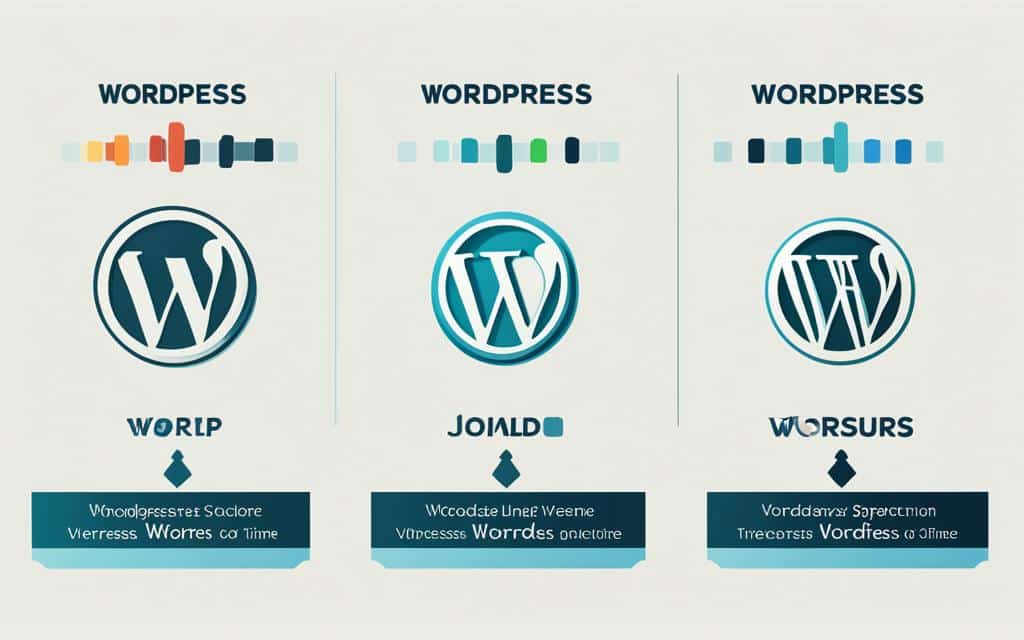Table of Contents
WordPress is the most popular Content Management System (CMS) globally, powering over 835 million websites. To ensure optimal website performance and security, it is essential to stay updated with the current version of WordPress. In this comprehensive update guide, we will discuss everything you need to know about the current version of WordPress and how to update your website.
WordPress Versions: Major vs. Minor
In the world of WordPress, updates come in two categories: major and minor versions. Let’s explore the differences between them and understand their significance.
Major Updates: Embracing Change
WordPress major versions signify significant changes to the core software. These updates often introduce new features, enhanced functionality, and improvements to the overall user experience. Each major release is named after a legendary Jazz musician, continuing the tradition of paying homage to musical icons.
Did you know? As of the latest release, WordPress has had a total of 46 major updates, with version 6.4, aptly named “Shirley,” being the most recent.
Minor Updates: Polishing the Experience
On the other hand, minor updates focus on bug fixes, security enhancements, and minor improvements. They refine the existing features and address any issues discovered after major releases. With over 500 minor versions released to date, WordPress consistently strives to fine-tune its software and provide a seamless user experience.
It’s worth noting that minor updates are crucial for maintaining the stability and security of your WordPress website.
By staying up-to-date with both major and minor updates, you can take advantage of the latest features, enjoy improved performance and security, and ensure a smooth user experience.
How to Check Your Current WordPress Version
Checking your current WordPress version is an essential step in ensuring that your website is up to date and secure. Fortunately, there are multiple methods available to check your WordPress version.
Method 1: Admin Dashboard
You can easily find your current WordPress version through the admin dashboard. Simply follow these steps:
- Login to your WordPress admin dashboard.
- Locate the “At a Glance” section on the dashboard home page.
- Check the “WordPress” version displayed in this section.
This method provides a quick and convenient way to determine your current WordPress version.
Method 2: About WordPress Page
Another way to check your WordPress version is by accessing the “About WordPress” page. Here’s how:
- Click on the WordPress logo in the top-left corner of the admin dashboard.
- From the dropdown menu, select “About WordPress”.
- You will be redirected to a page displaying detailed information about your WordPress installation, including the current version.
By following these steps, you can easily find your WordPress version through the admin dashboard.
Method 3: Page Source and RSS Feed
If you prefer a more technical approach, you can check your WordPress version through the page source or the RSS feed of your website. Here’s how:
Page Source:
- Open your website in a web browser.
- Right-click anywhere on the page and select “View Page Source” or “Inspect Element”.
- In the source code, search for “
wp-includes/version.php“. - Look for the line “
$wp_version = 'X.X.X';“. The number within the single quotes represents your WordPress version.
This method requires a basic understanding of HTML and may be more suitable for advanced users.
RSS Feed:
- Append “
?feed=rss2” to your website’s URL. - Open the modified URL in your web browser.
- Search for the “
<generator>” tag in the displayed XML code. - The content within the tag will indicate your WordPress version.
These methods may be useful if you prefer manual inspection using the page source or the RSS feed.
Now that you know how to check your current WordPress version, you can determine if an update is needed to keep your website secure and functioning optimally.
How to Upgrade to the Latest WordPress Version
Ensuring website security and performance is crucial, and upgrading to the latest WordPress version plays a significant role in achieving this. By upgrading, you can take advantage of bug fixes, security patches, and new features that enhance your website’s functionality and user experience. Follow these steps to upgrade your WordPress installation to the latest version:
- Step 1: Check for Updates
- Step 2: Backup Your Website
- Step 3: Click on “Update Now”
- Step 4: Verify the Upgrade
Log in to your WordPress admin dashboard and navigate to the ‘Updates’ section. Here, you can see if a new version is available for your WordPress installation.
Before proceeding with the upgrade, it is highly recommended to back up your website’s files and database. This ensures that you can restore your website to its previous state if any issues occur during the upgrade process.
If a new version is available, you will see an “Update Now” button. Simply click on it, and WordPress will automatically download and install the latest version.
After the upgrade process is complete, ensure that your website is functioning correctly. Check all pages, posts, plugins, and themes for any compatibility issues that may have arisen during the upgrade.
It’s important to note that while WordPress offers automatic updates for minor versions, major versions may require a manual initiation, as they often involve significant changes to the core software. Keeping your WordPress installation up to date is an essential step in maintaining a secure and optimized website.
How to Downgrade WordPress to a Previous Version
In some cases, you may need to downgrade WordPress to a previous WordPress version due to compatibility issues with plugins or themes. To do this, you can use a plugin like WP Downgrade or manually upload the desired version via FTP. It is important to note that downgrading WordPress should only be done if necessary, as using outdated versions may pose security risks.
If you encounter compatibility issues with the latest version of WordPress and need to revert to a previous version, follow these steps:
- Identify the specific version you want to downgrade to. This can be based on your prior experience with a stable version or recommendations from plugin or theme developers.
- If using a plugin, such as WP Downgrade, install and activate it on your WordPress site. The plugin will allow you to select and install a specific previous version of WordPress.
- Access the plugin’s settings and choose the desired WordPress version you want to downgrade to. The plugin will automatically handle the installation process for you.
- If you prefer to downgrade manually via FTP, visit the official WordPress Releases Archive (https://wordpress.org/download/releases/) and download the desired version’s zip file.
- Extract the contents of the downloaded zip file to your local computer.
- Connect to your website’s FTP server using an FTP client, such as FileZilla.
- Navigate to the root directory of your WordPress installation.
- Delete the existing WordPress files and folders, excluding your wp-config.php file and the wp-content folder which contains your plugins, themes, and media.
- Upload the extracted contents of the previous WordPress version using FTP, replacing the deleted files and folders.
- Once the upload is complete, visit your website to ensure that it is functioning correctly with the downgraded version of WordPress.
Important Considerations:
Security Risks: Using outdated versions of WordPress may expose your website to security vulnerabilities. Only downgrade to a previous version if absolutely necessary, and be sure to monitor security alerts and update to the latest version as soon as compatibility issues are resolved.
Compatibility: Downgrading WordPress may resolve compatibility issues with certain plugins or themes, but it can also introduce new compatibility issues with other components. Carefully test your website’s functionality after the downgrade and address any unexpected issues that may arise.
By following these steps, you can successfully downgrade your WordPress installation to a previous version and address compatibility challenges while keeping security risks in mind.
| Downgrading WordPress | Benefits |
|---|---|
| Resolve compatibility issues | Ensure proper functioning of plugins and themes |
| Address specific version-related bugs | Improve website stability |
| Restore a previously tested and reliable version | Regain trust in your website’s performance |
How to Hide the WordPress Version Number
If you want to hide the WordPress version number on your website for security reasons, there is a simple way to do so by editing your theme’s functions.php file. By adding a few lines of code, you can prevent anyone from easily identifying the WordPress version used by your site, adding an extra layer of protection.
To get started, follow the steps below:
- Access your WordPress theme files. You can do this by logging into your website’s hosting account and navigating to the file manager or by using an FTP client.
- Locate the functions.php file within your active theme’s directory. This file is responsible for handling various functions and features of your theme.
- Open the functions.php file using a text editor, such as Notepad or Sublime Text.
- Add the following lines of code at the end of the file, just before the closing PHP tag (<?php … ?>):
function remove_wordpress_version() {
return '';
}
add_filter('the_generator', 'remove_wordpress_version');
This code snippet creates a new function called remove_wordpress_version() and uses the add_filter() function to insert this function into the WordPress generator tag. By returning an empty string, the generator tag, which typically displays the WordPress version number, will no longer be rendered.
Once you have added the code, save the functions.php file and upload it back to your server, replacing the old file if prompted.
Now, when someone inspects the source code of your website or uses tools to identify the WordPress version, the version number will not be visible, therefore making it more challenging for potential hackers or attackers to exploit known vulnerabilities specific to older versions.
Remember to always keep a backup of your theme files, especially before making any modifications. This will allow you to revert back to the previous version in case any issues arise.
By hiding the WordPress version number, you can minimize the risk of potential attacks on your website and maintain a higher level of security. It is an important step towards protecting your site and ensuring the safety of your valuable data.
Latest WordPress Version: What’s New
The latest major release of WordPress is version 6.4, named “Shirley.” This version introduces exciting enhancements to the Footnotes block, providing users with more customization options. Now, you can fully personalize the look and feel of your footnotes by customizing the link, background, and text colors. This feature allows you to create visually appealing and cohesive designs that align with your website’s branding.
By staying updated with the latest version of WordPress, you gain access to these new features and improvements. Embracing the new customization options for the Footnotes block enables you to enhance the overall visual experience of your content. Whether you’re a blogger, content writer, or website owner, leveraging the latest WordPress version empowers you to create engaging and dynamic web pages.
Stay tuned for the release of WordPress 6.4 “Shirley” and experience the modern and versatile Footnotes block enhancements firsthand!
Conclusion
Keeping your WordPress website updated to the latest version is essential for maintaining its security and performance. With each new version, WordPress brings important bug fixes, security patches, and exciting new features. Regularly checking your current version, upgrading or downgrading if necessary, and taking steps to hide the WordPress version number are all vital in ensuring the smooth and secure operation of your website.
By staying up to date with the latest WordPress version, you can protect your website from vulnerabilities and potential security risks. This also allows you to take advantage of the latest features and improvements that WordPress has to offer. Whether it’s through the simple “Update Now” button or manual upgrades, upgrading WordPress ensures that you are benefiting from the latest advancements in the platform.
Additionally, it’s crucial to remember that downgrading WordPress should only be done when absolutely necessary, as using outdated versions can expose your website to security threats. By prioritizing regular updates, you can provide your visitors with a secure and user-friendly experience on your WordPress site.
Lastly, taking the necessary steps to hide the WordPress version number can further enhance the security of your website. By concealing this information, you make it more difficult for potential attackers to identify the specific version of WordPress you are using, reducing the risk of targeted attacks.
FAQ
What is the latest version of WordPress?
The latest version of WordPress is version 6.4, released in 2024.
How many major WordPress releases are there?
There have been 46 major WordPress releases to date.
How many minor WordPress releases are there?
WordPress has released over 500 minor versions so far.
How can I check my current WordPress version?
You can find your current WordPress version in the “At a Glance” section of your admin dashboard or by going to the “About WordPress” page. You can also check the version through the page source or RSS feed of your website.
Why is it important to upgrade to the latest WordPress version?
Upgrading to the latest WordPress version is important for optimal website performance and security.
How do I upgrade to the latest WordPress version?
To upgrade to the latest WordPress version, simply click on the “Update Now” button in your admin dashboard if a new version is available. It is recommended to backup your website before upgrading.
How do I downgrade WordPress to a previous version?
To downgrade WordPress, you can use a plugin like WP Downgrade or manually upload the desired version via FTP.
Is it safe to use outdated versions of WordPress?
Using outdated versions of WordPress may pose security risks, so it is generally not recommended.
How can I hide the WordPress version number on my website?
You can hide the WordPress version number by adding a few lines of code to your theme’s functions.php file.
What’s new in the latest WordPress version?
The latest WordPress version, version 6.4 (named “Shirley”), introduces enhancements to the Footnotes block, including support for link, background, and text color customization.












